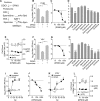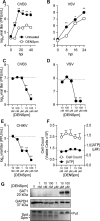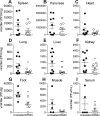Inhibition of Polyamine Biosynthesis Is a Broad-Spectrum Strategy against RNA Viruses
- PMID: 27535047
- PMCID: PMC5068521
- DOI: 10.1128/JVI.01347-16
Inhibition of Polyamine Biosynthesis Is a Broad-Spectrum Strategy against RNA Viruses
Abstract
RNA viruses present an extraordinary threat to human health, given their sudden and unpredictable appearance, the potential for rapid spread among the human population, and their ability to evolve resistance to antiviral therapies. The recent emergence of chikungunya virus, Zika virus, and Ebola virus highlights the struggles to contain outbreaks. A significant hurdle is the availability of antivirals to treat the infected or protect at-risk populations. While several compounds show promise in vitro and in vivo, these outbreaks underscore the need to accelerate drug discovery. The replication of several viruses has been described to rely on host polyamines, small and abundant positively charged molecules found in the cell. Here, we describe the antiviral effects of two molecules that alter polyamine levels: difluoromethylornithine (DFMO; also called eflornithine), which is a suicide inhibitor of ornithine decarboxylase 1 (ODC1), and diethylnorspermine (DENSpm), an activator of spermidine/spermine N1-acetyltransferase (SAT1). We show that reducing polyamine levels has a negative effect on diverse RNA viruses, including several viruses involved in recent outbreaks, in vitro and in vivo These findings highlight the importance of the polyamine biosynthetic pathway to viral replication, as well as its potential as a target in the development of further antivirals or currently available molecules, such as DFMO.
Importance: RNA viruses present a significant hazard to human health, and combatting these viruses requires the exploration of new avenues for targeting viral replication. Polyamines, small positively charged molecules within the cell, have been demonstrated to facilitate infection for a few different viruses. Our study demonstrates that diverse RNA viruses rely on the polyamine pathway for replication and highlights polyamine biosynthesis as a promising drug target.
Copyright © 2016, American Society for Microbiology. All Rights Reserved.
Figures






References
-
- Mounce BC, Poirier EZ, Passoni G, Simon-Loriere E, Cesaro T, Prot M, Stapleford KA, Moratorio G, Sakuntabhai A, Levraud J-P, Vignuzzi M. 2016. Interferon-induced spermidine-spermine acetyltransferase and polyamine depletion restrict Zika and chikungunya viruses. Cell Host Microbe 20:167–177. doi:10.1016/j.chom.2016.06.011. - DOI - PubMed
MeSH terms
Substances
Grants and funding
LinkOut - more resources
Full Text Sources
Other Literature Sources
Research Materials

